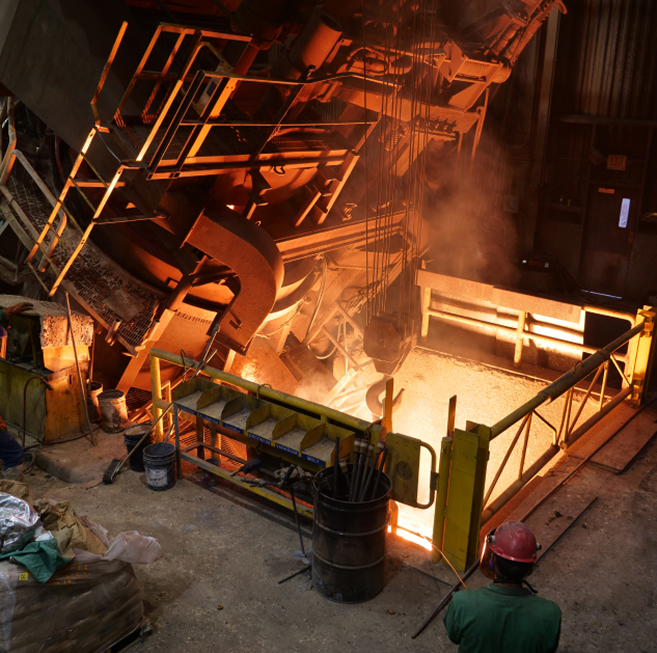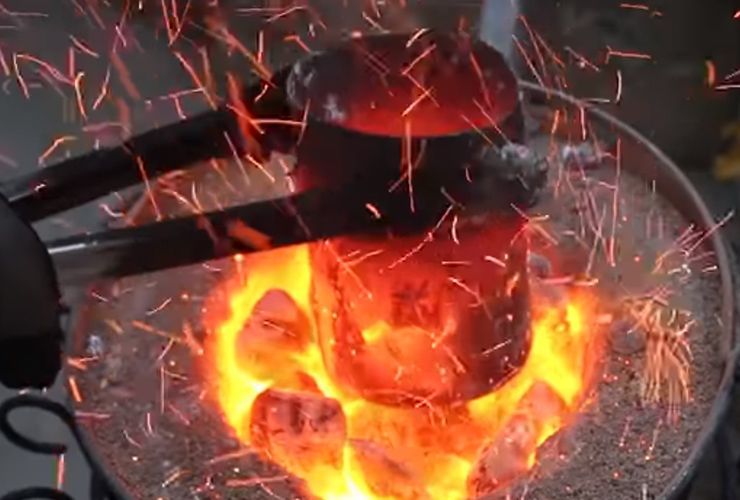How Aluminum Foundry Methods Are Changing Modern Manufacturing
Wiki Article
All Regarding Metal Casting: Just How Foundries Provide High Quality and Precision in Production
Metal casting stands as a fundamental process in manufacturing, where raw steels are changed right into particular elements. Foundries employ numerous casting techniques to achieve preferred characteristics and forms. Each approach features its own set of restrictions and advantages. Understanding these nuances is crucial for valuing just how quality and precision are maintained throughout the process. The conversation ahead will certainly check out the elaborate characteristics of metal casting and its relevance across numerous industries.The Essentials of Metal Casting
Metal casting is an essential procedure in manufacturing that entails forming molten metal into wanted kinds. This vital technique begins with the selection of basic materials, typically various metal alloys, which are thawed in a heater. When the metal reaches the ideal temperature level, it comes to be liquid and ready for casting.The process requires a mold and mildew, commonly made from sand, metal, or ceramic, which defines the last form of the actors item. As soon as the liquified metal is put right into the mold and mildew, it solidifies and cools down, tackling the mold and mildew's shapes.
After cooling down, the casting is eliminated from the mold, and any required finishing processes, such as trimming or brightening, are carried out. This technique enables makers to create complicated shapes and components with high precision and marginal waste. Metal casting is extensively utilized across different markets, from vehicle to aerospace, emphasizing its importance in modern-day manufacturing.
Types of Casting Methods
While numerous casting techniques exist, each method uses one-of-a-kind benefits and is suited for various applications. Sand casting, one of the most usual approaches, uses sand as the mold and mildew material, enabling intricate layouts and big parts. Investment casting, recognized for its precision, utilizes a wax pattern coated in ceramic, making it ideal for intricate geometries. Die casting, which entails requiring molten metal right into molds under high pressure, is frequently made use of for mass production of small, thorough elements. In addition, shell molding combines sand and material to create thinner, a lot more accurate mold and mildews, enhancing surface area finish. An additional method, continual casting, allows the manufacturing of lengthy lengths of metal forms, streamlining production procedures. Each of these approaches plays a critical function in the metal casting sector, addressing specific demands from production quantity to create complexity, consequently adding to the diversity of applications across different industries.The Duty of Foundries in Production
Foundries serve an essential function in the production landscape, as they change raw metals into functional parts through different casting procedures. These centers employ a variety of strategies to create products that satisfy exact requirements, thus ensuring high quality and performance in manufacturing (Aluminum Casting). By utilizing techniques such as sand casting, financial investment casting, and pass away casting, shops satisfy diverse industries, including vehicle, aerospace, and building and construction
Inevitably, shops are integral to the manufacturing environment, giving important components that sustain a wide variety of sectors and applications. Their precision and versatility drive performance in modern production.
Products Used in Metal Casting
The choice of products used in metal casting is essential for accomplishing the wanted residential properties and efficiency of the end product. Numerous metals such as iron, bronze, and light weight aluminum are generally used, each offering unique advantages. Light weight aluminum is favored for its corrosion-resistant and light-weight high qualities, making it excellent for auto and aerospace applications. Iron, especially cast iron, is understood for its outstanding fluidness and toughness, suitable for hefty equipment and infrastructure components. Bronze, with its premium wear resistance, is typically used in aquatic settings.In addition, products such as silica sand are regularly made use of for mold and mildew production, giving a great equilibrium in between resilience and simplicity of shaping. The choice of materials also includes additives like changes, which boost the casting procedure by boosting fluidness and minimizing oxidation. Inevitably, the ideal selection of these materials considerably affects the effectiveness and high quality of the casting process.
Quality assurance in the Casting Process
Quality control in the casting procedure is important to guarantee that final products meet sector criteria and requirements. Different examination strategies are used to recognize defects and evaluate the stability of cast elements. In addition, adherence to established certifications and criteria improves the integrity and performance of cast products.Inspection Techniques Employed
Keeping the stability of cast metal parts counts heavily on various examination strategies. Foundries utilize visual inspections as an initial measure to identify surface area issues, such as incorporations or fractures. Non-destructive testing (NDT) techniques, consisting of ultrasonic screening and radiographic evaluation, are essential for spotting inner defects without endangering the part's integrity. Dimensional examinations utilizing calipers and coordinate measuring equipments verify that elements meet specified resistances. Additionally, chemical evaluation verifies that the alloy structure aligns with called for standards. These examination methods collectively verify that the castings fulfill the needed high quality and efficiency requirements, ultimately decreasing the danger of failure in their designated applications. Executing these rigorous assessments is fundamental for keeping high criteria in metal casting manufacturing.Criteria and Certifications
Requirements and qualifications play a crucial duty in the quality control of the casting procedure. Foundries adhere to different global and industry-specific standards, such as ISO 9001 and ASTM standards, guaranteeing uniformity and dependability in their items. These requirements describe the required standards for materials, production approaches, and screening treatments, adding to a much more effective production process. Certifications, such as AS9100 for aerospace applications, further highlight the value of high quality assurance in specialized industries. By getting these qualifications, shops show their dedication to excellence, enhancing and reducing defects consumer complete satisfaction. Regular audits and inspections confirm conformity, cultivating continual enhancement and advancement within the market. Eventually, adherence to established requirements grows count on between clients and suppliers.Innovations in Casting Technology

3D Printing Integration
Incorporating 3D printing technology into metal casting procedures is transforming the manufacturing landscape. This cutting-edge fusion improves the layout and manufacturing of complex geometries that traditional techniques struggle to achieve. By employing additive production for producing molds and cores, shops can significantly reduce preparations and material waste. 3D printing permits for quick prototyping, making it possible for suppliers to check styles swiftly and successfully, therefore promoting iterative renovations. This modern technology likewise supports the production of lightweight parts, which are important in industries such as aerospace and auto. Therefore, the combination of 3D printing not only simplifies procedures however likewise elevates the precision click to investigate and top quality of actors metal items, marking a significant innovation in the sector.Automated Production Processes
The developments in 3D printing have paved the way for further innovations in computerized manufacturing processes within metal casting. Foundries are significantly embracing robotics and automation to enhance efficiency and precision. Automated systems simplify the whole casting workflow, from mold and mildew development to completing and pouring. Smart sensing units and real-time monitoring permit for exact control of temperatures and product flow, decreasing waste and improving high quality. Furthermore, software solutions promote much better design and simulation, making it possible for makers to maximize procedures prior to production starts. These automated manufacturing processes not only lower labor costs however also reduce human mistake, ensuring constant result. Because of this, the combination of advanced modern technologies in metal casting is transforming manufacturing capabilities and satisfying the expanding needs of various sectors.Advanced Material Advancement
As sectors demand higher efficiency and sustainability, developments in material growth for metal casting are emerging as an essential focus. Engineers and scientists are discovering new alloys and compounds that boost mechanical homes while decreasing ecological influence. Innovations consist of lightweight materials that maintain toughness, making it possible for far better gas effectiveness in transportation applications. Additionally, the incorporation of recycled materials is coming to be extra widespread, lining up with sustainability goals. Advanced casting techniques, such as 3D printing and precision molding, allow for the creation of complex geometries that traditional methods can not achieve. These growths not just enhance the functionality of cast components but additionally boost production performance. On the whole, the continual advancement of material science drives the future of metal casting, meeting the demands of modern-day industries.
Applications of Metal Casting Across Industries
Metal casting plays a necessary duty in numerous markets, as it enables the production of intricate shapes and premium components with advice relative efficiency - Aluminum Foundry. In the automobile industry, cast metals are essential for developing engine blocks, transmission cases, and various other vital parts that require durability and precision. Aerospace industries utilize metal casting for components like wind turbine blades and architectural aspects, where reliability is extremely importantAdditionally, machinery and devices manufacturing take advantage of metal casting by producing equipments, housings, and other detailed parts that improve capability. The building market additionally employs metal casting for building attributes, structural supports, and installations, showcasing convenience.
The clinical area counts on cast metals for surgical instruments and implants, stressing the demand for biocompatibility. Overall, metal casting is a fundamental process across several markets, giving solutions that meet stringent top quality criteria and performance requirements.
Frequently Asked Questions
What Precaution Are Absorbed Metal Casting Foundries?
In metal casting factories, safety and security actions consist of safety equipment, air flow systems, normal tools upkeep, staff member training, and emergency situation methods to mitigate risks related to high temperatures, hazardous materials, and potential crashes throughout the casting procedure.Exactly How Do Foundries Handle Waste and Environmental Effect?
Foundries manage waste and environmental impact via reusing products, carrying out filtering systems for discharges, and adhering to regulations - Aluminum Casting. They additionally take on sustainable practices, such as reducing power intake and using environment-friendly compounds in their processesWhat Are the Prices Connected With Metal Casting Processes?
The costs linked with metal casting processes include basic materials, labor, tools maintenance, energy intake, and waste administration. Furthermore, fluctuations in market prices and compliance with environmental regulations can greatly influence overall expenditures for factories.How Does Metal Casting Contrast to Other Manufacturing Approaches?
Metal casting supplies unique benefits, such as complex forms and high material efficiency, compared to techniques like machining or stamping. It may include much longer lead times and greater first expenses, depending on task specifications.
What Occupation Opportunities Exist in the Metal Casting Sector?
The metal casting sector supplies different career possibilities, consisting of shop management, process design, quality control, mold layout, and machine procedure. Specialists can additionally seek duties in r & d, sales, and check my site ecological health and security.Metal casting stands as a fundamental process in production, where raw metals are changed right into particular parts. Metal casting is an essential process in making that involves forming molten metal right into preferred forms. One more approach, continual casting, allows the manufacturing of long sizes of metal forms, improving manufacturing procedures. The costs associated with metal casting processes consist of raw materials, labor, devices upkeep, power intake, and waste administration. The metal casting market uses numerous occupation chances, consisting of shop management, process engineering, top quality assurance, mold layout, and device operation.
Report this wiki page